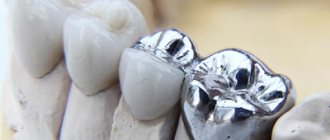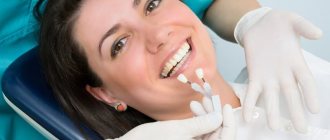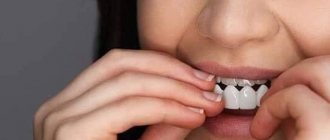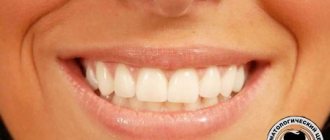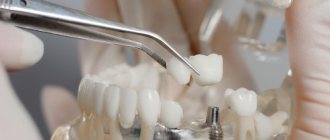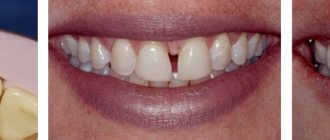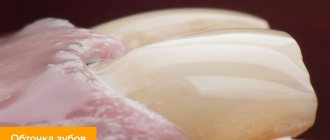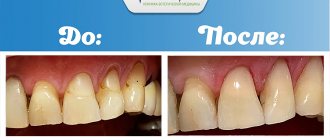Ceramic veneers Stages of making ceramic veneers Composite veneers Zirconium veneers
We live in amazing times: to get a snow-white smile with perfectly straight teeth, you don’t have to wear braces or have whitening every 2 years. It is enough to install thin overlays on the teeth - veneers. A quick, painless procedure and the smile of your dreams will always be with you.
Veneers appeared in Hollywood in the first half of the 20th century. Although actors used pads constantly, the technology was not widely used - the products were fragile and did not hold up well. It was only at the end of the 20th century that technology was developed that helped veneers become popular.
Dental microprostheses for covering the front surfaces of teeth are made from ceramics, zirconium dioxide and composites. The technique and production time depend on the material. Each method has its pros and cons.
Types of ceramic veneers
The classification of veneers is related to their manufacturing technologies.
Pressed veneers are made from dental porcelain. As a result, an ultra-thin plate is created, which is subsequently ground and glazed, which creates a pleasant natural shine. A similar technique is used to create ultra-thin E-max ceramic veneers.
Zirconium veneers are a separate type of ceramic veneers that are made from zirconium dioxide. The basis of the two-layer structure is a zirconium plate. A ceramic layer is applied to it. The zirconium frame provides extra strength.
Other benefits include:
• the shade does not change over time; • thickness of only 0.3 mm ensures invisibility; • does not cause allergies; • service life 20 years.
Not everyone can afford the price. This is the drawback.
A popular service at our clinic is the installation of feldspathic veneers. During their manufacture, the technician applies ceramics layer by layer, which is a precise, highly artistic work. The ceramic layers are no more than a fraction of a millimeter. During the specialist’s work, anthropometric data are taken into account. With their help, it is possible to present the overall picture of the dentition, the smile line, and plan the ideal shape of the structure. As a result, feldspathic veneers cannot be distinguished from natural teeth. .
Read also
How to close a gap between your front teeth
When thinking about how to remove a gap between teeth, it is important to learn as much as possible about this defect and how to eliminate it.
How long do you wear braces and what affects the timing?
When deciding on the use of orthodontic structures, patients are often interested in how long they wear braces on their teeth.
Manufacturing and installation
Ceramic veneers are installed after successive stages of work by a doctor at the ROCOSCLINIC clinic.
1. Consultation - a specialist finds out what aesthetic problems concern the client. The bite, defects, and enamel shade are taken into account. 2. The technician performs virtual modeling of teeth using a computer program. With the help of simple manipulations, thanks to mock-up technology, the formed volume of teeth helps to create temporary plastic structures. 3. Fitting, approval of the shape and color of the crown of the teeth. 4. Fixation of permanent ceramic restorations using a microscope ensures high precision.
Products are manufactured in our dental laboratory.
Types of temporary microprostheses, including preparation and creation of impressions
What types of removable veneers are there?
- temporary plates - such plastic overlays are installed by the doctor in the dental office, after preparing and preparing the teeth for the installation of permanent structures. They will need to be worn until permanent ceramic or, for example, zirconium plates are ready. By the way, many people are interested in the question of how old people are to get veneers. So, a similar procedure is performed on patients at least 18 years of age,
- removable template mouthguards and overlays - you can buy them on the Internet, pharmacy or cosmetics store. However, they are really of little use - neither cosmetic mouth guards nor overlays with a cheap adhesive composition will stick to the teeth for a long time and reliably. Moreover, they can damage the enamel and mucous membranes, provoke inflammation,
- individual removable Snap-On Smile - such cosmetic prostheses are made from impressions exclusively in the laboratories of the American company DenMat in the USA or Europe. That is, in a Russian clinic you can undergo all the preparatory procedures, but you will have to wait about a month for the arrival of the finished plates. Such designs, by the way, also allow you to disguise missing teeth. However, experts do not recommend wearing them on a permanent basis - this is an acceptable option as a temporary measure.
How is a ceramic veneer different from a lumineer?
Ceramic veneers and lumineers are not the same thing. Lumineers are also dental coverings, only:
• veneers are thicker, so you have to grind off the enamel layer before installing them. In addition, at the junction of the gum and the attachment of the plate, after a while a small space may form where food debris will accumulate; • the warranty period for veneers is shorter; • veneers are cheaper than lumineers.
Lumineers have recently appeared. People often call them “Hollywood”, as they help create the snow-white smile of celebrities.
Removable veneers – what are they and how to use them? How justified is such a purchase?
In pursuit of a flawless smile, many are often tempted by the advertising promises of manufacturers of inexpensive removable veneers. In such cases, most often we are talking about budget cosmetic mouthguards made of plastic or sets of template plates, which you need to attach to your teeth yourself using dubious glue from the packaging. Both options have many significant disadvantages. Therefore, in today’s article we will talk in detail about whether it is possible to insert removable veneers yourself and whether they are worth using at all.
Caring for ceramic veneers
After ceramic veneers have been installed, you should not forget about the features of oral care.
1. It is necessary to avoid severe mechanical stress and consumption of solid food. All this can lead to damage to the product; 2. You cannot eat cold and hot foods at the same time. Alternating contrasting temperature conditions can cause the ceramic veneer to crack. 3. There is no need to use pastes containing abrasive substances, otherwise the ceramics are subject to microcracks. It is in them that coloring substances accumulate, which over time spoil the appearance of the veneers. 4. You should pay attention to your toothbrush. Her bristles should be soft. To treat the surface of teeth not covered with veneers, you can use a brush with medium hardness. Vibrating brushes can promote peeling of records, so the choice should be in favor of simple ones. 5. It is necessary to include the use of an irrigator into a healthy habit. A stream of water removes food between the teeth where the brush did not reach; micromassage exerts pressure on the gums. All this has a beneficial effect on gum health.
It makes sense to regularly visit the dentist of the ROCOSCLINIC clinic in order to promptly eliminate problems and carry out professional hygiene.
Despite the strength of the structure, it is necessary to adhere to these recommendations. Ceramic veneers will last longer and look better if you take proper care of your mouth.
UDC 616.314-74
Advantages of adhesive technologies when fixing veneers to tooth tissue. Selection of adhesive system.
Advantages of adhesive technology for cementation of veneers to the tooth structure. Choice of adhesive system .
Authors: Shpak Elena Igorevna – Russian Federation, Penza, Penza State University, Medical Institute, Faculty of Dentistry, student.
Galkin Alexey Nikolaevich – Russian Federation, Penza, Penza State University, Medical Institute, Faculty of Dentistry, student.
Udaltsova Ekaterina Valerievna – Russian Federation, Penza, Penza State University, Medical Institute, Faculty of Dentistry, assistant at the Department of Dentistry.
Authors: Shpak Elena Igorevna – Russian Federation, Penza, Penza State University, Medical Institute, Faculty of Dentistry, student.
Galkin Aleksey Nikolaevich - Russian Federation, Penza, Penza State University, Medical Institute, Faculty of Dentistry, student.
Udaltcova Ekaterina Valerevna – Russian Federation, Penza, Penza State University, Medical Institute, Faculty of Dentistry, Assistant of the Department “Dentistry”
Abstract : This article discusses adhesive systems that are used in modern dentistry, as well as the features of their use. In the aspect of clinical assessment, the theoretical justification for the feasibility of a differentiated approach to the selection of a particular adhesive according to the clinical situation and the establishment of a relationship between the adhesive system used and the quality of the restoration performed is highlighted.
Abstract : this article discusses the adhesive systems that are used in modern dentistry, as well as features of their application. In the aspect of clinical evaluation, the theoretical substantiation of the feasibility of a differentiated approach to the choice of an adhesive according to the clinical situation and the establishment of the relationship between the adhesive system and the quality of the restoration.
Key words : adhesion, adhesive systems, veneers.
Keywords : adhesion, adhesivesystems, veneers.
In modern dentistry, the search for new materials and techniques that make it possible to reproduce the most natural and reliable restorations is still ongoing. The modest selection of dental materials made this task previously unfeasible. Nowadays, improvements in ceramic materials and adhesive systems are creating more treatment options that can provide a favorable and long-term prognosis for restorations.
Ceramic veneers are considered the latest achievement in aesthetic dentistry. They are in many ways superior to any previously existing restoration methods. Their advantages include a combination of natural appearance and reliable fixation, and direct manufacturing procedures do not affect the adjacent periodontal tissue. As soon as veneers became firmly established in use, they immediately became the basis for most aesthetic dental procedures.
Not only the appearance of veneers on the dental market, but the introduction of adhesives revolutionized dentistry, ensuring reliable fixation between ceramics and the tooth surface. The advent of multi-stage adhesive systems and total etching techniques made it possible to further increase the strength of adhesion to enamel and dentin. With the help of modern adhesive systems, ceramic veneers become biologically compatible with oral tissues, and also provide excellent aesthetic results and reliable functionality. In its properties, ceramics are close to natural enamel, which became the main basis for choosing this material when making veneers. It is generally accepted that the preparation depth for using these structures should be at least 0.5 mm, but in practice the thickness of the manufactured veneers varies from 0.4 to 0.7 mm, which fully corresponds to the thickness of natural enamel. This is why, due to the ability to preserve natural tissue, they are an excellent alternative to full crowns.
An adhesive system is a set of fluids that include different combinations of etchants such as primer and bond. They promote micromechanical fixation of dental materials to the hard tissues of the tooth. Adhesive is literally translated from English as “adhesive substance.” In dentistry, it is used to bond various materials to the tooth through surface adhesion, which occurs through the formation of molecular bonds. As a result, all tooth irregularities are filled with a material such as adhesive, which increases the contact area between the tooth surface and veneer.
There are different types of adhesive systems. Separately for enamel, as well as for enamel and dentin simultaneously. The composition of the systems can be one-, two- or multi-component. According to the curing method, self-curing, light-curing and dual-curing are distinguished. Depending on the filler - filled or unfilled. A system containing acid is called self-etching [1].
For each material, a unique adhesive system is usually developed, but there are also universal ones that are capable of fixing composites, compomers, metals and ceramics to dentin and enamel.
The primer included in any system has a complex chemical complex, including hydrophilic monomers, filler, solvent, initiator and stabilizer. The latter is designed to impregnate dentin structures to form a hybrid, smear layer. The bond, or the adhesive itself itself, is also a complex chemical complex and includes, in addition to a solvent, filler, initiator, and stabilizer, also hydrophobic high-molecular-weight methacrylates. The bond ensures the connection of the hydrophobic composite material with the etched enamel surface. The solvent is a chemical substance that helps maintain the liquid consistency of the material and the penetration of the components of the adhesive system into the tooth tissue. The filler is miniparticles of an inorganic substance (silicon oxide, acrosil), different in size (micrometers, nanometers ) and contained in a certain amount. The filler increases the stability and strength of the hybrid layer. The activator is included in the system as an additional component, which is used when working with orthopedic structures, amalgam, chemical and dual-curing composite materials. It ensures the self-curing of the system and is mixed with the primer and/or bond.
The conducted elementary analysis confirmed the possibility of completely restoring the original strength of teeth with the help of veneers, and this was later proven by other studies. In one experiment, veneers were cemented using VariolinkII cement on teeth with progressive aggressiveness to preparation. After the restoration, these teeth were subjected to a destructive load. There was no statistical difference between natural teeth that fractured under a load of 1100 N and teeth that were restored with veneers with preparation boundaries within the enamel. Later, during the study of the nature of the fractures, it was shown that not a single tooth had fractures in the area of adhesion , they were observed only in the thickness of the tooth or ceramics. When attaching veneers to composite restorations of class III or IV, the destructive load ranged from 800 to 1000 N, which corresponds to a slight decrease in values for teeth with a preparation boundary within the enamel. This experiment clearly determines that the use of composite materials when fixing veneers does not affect their strength. Also, the quality of the edge seal between the two layers of composite has been improved.
Veneers are characterized by two features. Firstly, these restorations are very thin and transparent, and secondly, veneers in most cases are fixed to the enamel. These features determine our choice of material for fixation, and in particular the need to use reliable enamel adhesives. However, there is also fixation to dentin. Therefore, when applying, you should choose universal bonding systems that involve separate etching of enamel and dentin with phosphoric acid [2].
Universal systems include a separate primer and adhesive, or a combination of both in one bottle. Any ceramics, including veneers, must be etched and then coated with silane immediately before fixation. This helps ensure that the wettability of the ceramic surface by the diacrylate resin is optimized. It is more often recommended to use a two-component silane. From the options for composite cements, we choose light-curing materials with low viscosity, since veneers are usually very thin and transparent. Only when fixing opaque, opaque veneers can dual-curing cements be used, given that over time this material acquires a dark yellow or brown color due to the amine content [3].
The connection of ceramics, which is etched with hydrofluoric acid, and tooth enamel, which is etched with phosphoric acid, using a composite material provides a strong and reliable bond. Hard dental tissues, ceramics and an adhesive agent are the main components. Moreover, the connection between ceramics and adhesive occupies a special place. This complex is able to withstand all types of loads, both mechanical (shock or fatigue), thermal, and hydraulic (infiltration and absorption of water), which are exerted on it in the oral cavity. However, chemically hard dental tissues, composite cements and ceramic restorations are completely dissimilar materials. Teeth are composed of enamel (86% hydroxyapatite, 12% water), dentin (45% hydroxyapatite, 30% collagen fibers, 25% water), pulp and other structures. Ceramics have absolutely no organic matter in their composition. Composites have both an organic matrix and an inorganic filler. The composition of all these components fully explains the impossibility of their combination in a direct chemical reaction. The developed idea of creating microretention on the enamel surface by acid etching has opened up new possibilities for stable fixation. Due to micromechanical interaction, a bond strength of 20 MPa was achieved between composite cements and completely inorganic enamel. The adhesive bond strength of the composite with etched and silane-treated ceramics reaches 45 MPa. These adhesive bond indicators are sufficient to resist the tensile and shear stresses that arise during thermal expansion of materials or during polymerization shrinkage of composites [4].
The inner surface of the restorations and the prepared tooth surface are prepared separately before adhesive fixation. Preparation of the inner surface of a ceramic veneer involves acid etching for 1 - 4 minutes (depending on the concentration of the etchant liquid and the method of making the restoration), as a result of which the inner surface of the veneer acquires a chalky tint. If individual, unetched areas with less pronounced chalkiness are preserved, they should be re-etched. The quality of the etching can also be checked by placing a drop of water on the inner surface of the veneer. If it is carried out adequately, a drop of water will spread over the entire treated surface [5].
Reliable adhesion of the composite material and ceramics is also achieved using micromechanical retention. Silicon oxide and lithium silicate ceramics contain a glass filler that is etched with hydrofluoric acid, exposing the crystals to form undercuts. The etched surface must be impregnated with resin to ensure microretention.
Ceramic materials based on aluminum oxide or zirconium do not have this chemical reaction, since they do not contain silicon oxide in their composition. Accordingly, it is impossible to roughen the surface of a product made from these materials by etching with hydrofluoric acid. For this purpose, sandblasting with aluminum oxide powder is used. The roughened surface is coated with silicon oxide and silanized to ensure deep resin penetration. This is achieved using tribochemical treatment. It consists of using high-energy particles that are coated with silicon oxide [6].
With the help of silane, silicon oxide (quartz) can be chemically bonded to acrylic or bis-GMA resin. There is no mutual bond between glazed porcelain and composite resin, even with the use of silane, until the ceramic surface is roughened. Microscopic pores of etched enamel are formed on the surface of the ceramic when exposed to hydrofluoric acid. This phenomenon occurs due to the selective dissolution of silica on the surface of ceramic restorations, with the exception of specimens made from alumina-based ceramics. An additional property of hydrofluoric acid is that it activates the surface of ceramic materials. Hydrofluoric acid alone or in combination with pre-sandblasting increases the microretention of the inner surface of the ceramic veneer.
The cohesive strength of ceramics and the bonding strength of composite cement to etched enamel are inferior to the bonding strength of composite cement to an etched ceramic surface. The characteristics of the etched ceramic surface and the strength of the bond of composite cement to it are determined by the concentration, as well as the exposure time of the acid, and the method of manufacturing the restoration.
To improve microretention, before fixing veneers on the prepared tooth surface, it is recommended to carry out treatment using special water-abrasive systems. This system is the latest development, the operation of which is based on the combined use of the energy of abrasive particles (powders of soda bicarbonate and aluminum oxide) with a flow of water. The action of the water-abrasive system allows you to remove demineralized areas of enamel and destructive dentin, which are an accumulation of destroyed tissues, microorganisms and do not perform their functions, as well as create a porous tooth surface that promotes better adhesion between veneers, bond and tooth tissues.
The micro-rough surface created using water-abrasive systems increases the area of contact between the hard tissues of the tooth and the adhesive system. The device allows you to treat hard dental tissues with aluminum oxide powder, which is supplied with a dispersion of 29 and 53 microns. To create a slight roughness, it is better to use powder with a dispersion of 29 microns. The device also has two dispensing chambers that allow the doctor to switch between two powders (bicarbonate of soda and aluminum oxide) without changing the tip. The three-position pedal allows you to prepare, rinse and dry in less time. The first press on the pedal turns on the flow of clean, dry air, the second switches on the flow of water, and the third press connects the flow of solid abrasive particles of bicarbonate of soda or aluminum oxide with water and air. The tip, which creates a water curtain around the abrasive powder, minimizes the formation of cracks and chips of the enamel, is convenient and easy to handle. To create a rough surface, aluminum oxide powder with a dispersion of 29 microns is used, a 0.6 mm tip at speed “B”, which creates a high-speed abrasive flow medium density. The tip is used to make circular movements along the vestibular surface of the prepared tooth. The tip nozzle must be held at an angle of 45 degrees to the tooth surface, at a distance of 3-4 mm [7].
Practicing dentists usually recommend using a full range of dental materials from one manufacturer, which additionally includes water-soluble cement simulator gels when trying on veneers (Nexus 2, SybronKerr, Calibra and others). Such gels allow you to evaluate the future aesthetic result of veneers before final fixation in the oral cavity. After fitting, the internal surfaces of the veneers are thoroughly cleaned and rinsed. Then gently wipe with a swab with distilled water, and only then clean with alcohol or acetone to remove traces of saliva or fat.
Long-term and successful functioning of veneers is possible only with reliable fixation of the ceramics with the composite, as well as the composite with the dental tissues. The correct choice of the desired adhesive system contributes to the complete restoration of the original strength of the teeth and the reliability of fixation. Modern adhesives make it possible to fix veneers not only to the surface of the enamel, but also to areas of dentin. Accurate adherence to the execution protocol and monitoring the condition of the working field are the main conditions for successful rehabilitation with the help of veneers.
Bibliography:
1. W. Blunk. / Adhesive systems: review and comparison // Dent Art. - 2003. - No. 2. - P. 5-11.
2. G. Gurel. /Ceramic veneers. Art and science. /Moscow, St. Petersburg, Kyiv, Almaty, Vilnius, - 2007, pp. 128-135.
3. F. Tey. / Modern adhesive systems // Dent Art. - 2003. - No. 2. - P. 13-16.
4. S.A. Gorban et al. /Modern adhesive systems. Self-etchprimer technique // Modern dentistry. - 2007. - No. 3. - P. 15-19.
5. S.N. Khramchenko, L.A. Kazeko. / Self-etching adhesive systems // Modern dentistry. - 2006. - P. 4-8.
6. Waning A., Smidt A., Van Pelt H. Directions in adhesive dentistry, clinical perspectives //Maestro of Dentistry.-2003.-No. 2.-P.73
7. Nakonechny D.A. Aquakinetic method in therapy // Vestnik magazine issue, No. 3, 2014.95 p.
List of references:
1. W. Blunck. / Adhesive systems: review and comparison // Dent Art. - 2003. - No. 2. - p. 5-11.
2. G. Gurel. Ceramic veneers. Art and science. / Moscow, St. Petersburg, Kiev, Almaty, Vilnius, - 2007- p. 128-135.
3. F. Tay. / Modern adhesive systems // Dent Art. - 2003. - No. 2. - p. 13-16.
4. SA Gorban et al. / Modern adhesive systems. Self-etchprimer technology // Modern dentistry. - 2007. - No. 3. - p. 15-19.
5. SN Khramchenko, LA Kazeko. / Self-Etching Adhesive Systems // Modern Dentistry. - 2006. - p. 4-8.
6. Waning A., Smidt A., Van Pelt H. Directions in adhesive dentistry, clinical perspectives // Maestro dentistry.-2003.-No. 2.-P.73
7. Nakonechny DA Aquakinetic method in therapy // Journal “Vestnik” issue, No. 3, 2014.95c.
Where is the ROCOSCLINIC clinic located?
Moscow is a city where you can get any dental service, one of which includes the installation of ceramic veneers. Call us, sign up for a consultation and we will be happy to consider your problem related to the aesthetic unattractiveness of your teeth.
The task of doctors is not only to treat, but also to restore the beauty of a smile. And it works out well. See for yourself. We know how to make your smile radiant and charming.
We are waiting for you at the address: Moscow, 17-Maryina Roshchi pr-d, no. 1.
